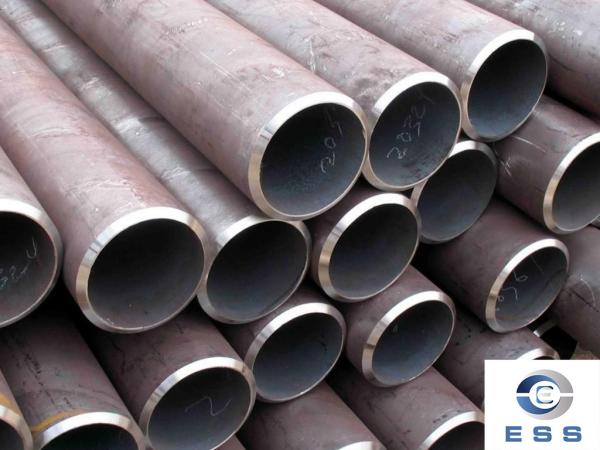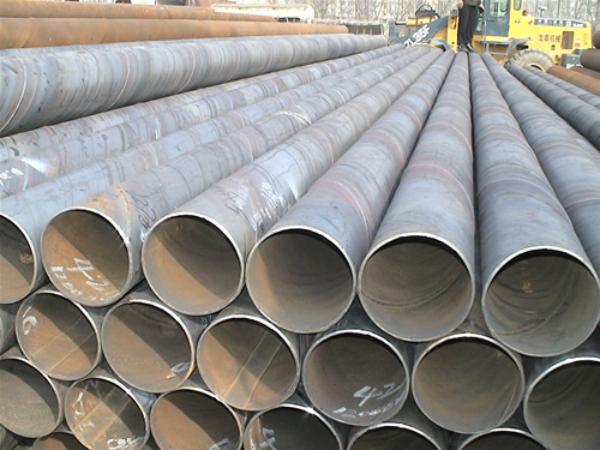Seamless vs welded pipe
Classification method of seamless pipe
A steel pipe that is seamless along the perimeter of its cross-section. According to different production methods, it is divided into hot-rolled pipe, cold-rolled pipe, cold-drawn pipe, extruded pipe, pipe jacking, etc., all of which have their own process regulations. The materials include ordinary and high-quality carbon structural steel (Q215-A~Q275-A and No. 10~50 steel), low alloy steel (09MnV, 16Mn, etc.), alloy steel, stainless acid-resistant steel, etc. According to the purpose, it is divided into two categories: general purpose (for water, gas pipelines and structural parts, mechanical parts) and special purpose (for boilers, geological exploration, bearings, acid resistance, etc.).

Classification method of welded pipe
According to different welding methods, it can be divided into arc welded pipes, high frequency or low frequency resistance welded pipes, gas welded pipes, furnace welded pipes, Bondi pipes, etc.
Electric welded steel pipe: used in oil drilling and machinery manufacturing, etc.
Furnace welded pipe: It can be used as water gas pipe, etc., large-diameter straight seam welded pipe is used for high-pressure oil and gas transportation, etc.; spiral welded pipe is used for oil and gas transportation, pipe piles, bridge piers, etc.

Classification by weld shape
Can be divided into straight seam welded pipe and spiral welded pipe
Longitudinal welded pipe
The production process is simple, the production efficiency is high, the cost is low, and the development is rapid.
Spiral welded pipe
The strength is generally higher than that of straight seam welded pipes, and welded pipes with larger diameters can be produced with narrower billets, and welded pipes with different diameters can also be produced with billets of the same width. But compared with the straight seam pipe of the same length, the weld length is increased by 30~100%, and the production speed is lower. Therefore, most of the welded pipes with smaller diameters adopt straight seam welding, and most of the large diameter welded pipes adopt spiral welding.
Spiral seam welded steel pipes are divided into automatic submerged arc welded steel pipes and high frequency welded steel pipes.
a. Spiral seam automatic submerged arc welded steel pipes are divided into Class A pipes and Class B pipes according to the pressure of the conveying medium. Class A pipes are generally welded with ordinary carbon steel Q235, Q235F and ordinary low-alloy structural steel 16Mn, and Class B pipes are welded with Q235, Q235F, Q195 and other steel materials, which are used as low-pressure fluid delivery pipes
b. Spiral seam high-frequency welded steel pipe There is no unified product standard for spiral seam high-frequency welded steel pipe, and it is generally made of ordinary carbon steel Q235, Q235F and other steel materials.
Classification by purpose
According to the purpose, it is divided into general welded pipe, galvanized welded pipe, oxygen blown welded pipe, wire casing, metric welded pipe, idler pipe, deep well pump pipe, automobile pipe, transformer pipe, electric welded thin-walled pipe, electric welded special-shaped pipe and spiral welded pipe.
General welded pipe
Generally, welded pipes are used to transport low-pressure fluids. Made of Q195A, Q215A, Q235A steel. It can also be manufactured from other mild steels that are easy to weld. Steel pipes are subject to water pressure, bending, flattening and other tests, and have certain requirements for surface quality. Usually, the delivery length is 4-10m, and it is often required to deliver in fixed length (or double length). The specification of the welded pipe is represented by the nominal diameter (mm or inch). The nominal diameter is different from the actual one. The welded pipe has two types of ordinary steel pipe and thickened steel pipe according to the specified wall thickness. The steel pipe is divided into two types: threaded and unthreaded according to the pipe end form.
Galvanized steel
In order to improve the corrosion resistance of steel pipes, general steel pipes (black pipes) are galvanized. There are two types of galvanized steel pipes: hot-dip galvanizing and electro-galvanizing. The hot-dip galvanizing layer is thicker and the cost of electro-galvanizing is low.
Oxygen welded pipe
Used as a pipe for oxygen blowing in steelmaking, generally small-diameter welded steel pipes, with eight types of specifications ranging from 3/8 inch to 2 inch. Made of 08, 10, 15, 20 or Q195-Q235 steel strip. In order to prevent corrosion, some are aluminized.
Wire Sleeve
It is an ordinary carbon steel electric welded steel pipe, which is used in concrete and various structural power distribution projects. The commonly used nominal diameter is from 13-76mm. The wall of the wire sleeve is relatively thin, and it is mostly used after coating or galvanizing, and a cold bending test is required
Metric welded pipe
The specifications are in the form of seamless pipes, and the welded steel pipes expressed by outer diameter * wall thickness mm are welded with ordinary carbon steel, high-quality carbon steel or ordinary low-alloy steel with hot or cold bands, or welded with hot bands and then cooled. Dial method made. Metric welded pipes are divided into ordinary energy and thin-walled pipes, which are generally used as structural parts, such as transmission shafts, or conveying fluids, and thin-walled pipes are used to produce furniture, lamps, etc., to ensure the strength and bending test of steel pipes.
roller tube
Electric welded steel pipes for belt conveyor rollers are generally made of Q215, Q235A, B steel and 20 steel, with a diameter of 63.5-219.0mm. There are certain requirements for the bending degree of the pipe, the end surface should be perpendicular to the center line, and the ellipticity, and the water pressure and flattening tests are generally carried out.
transformer tube
It is used to manufacture transformer cooling pipes and other heat exchangers. It is made of ordinary carbon steel and requires flattening, flaring, bending, and hydraulic tests. Steel pipes are delivered in fixed length or multiple lengths, and there are certain requirements for the bending degree of steel pipes.
Shaped tube
Square tubes, rectangular tubes, hat-shaped tubes, and steel pipes for hollow plastic steel doors and windows welded by ordinary carbon-bonded structural steel and 16Mn steel strips are mainly used as agricultural machinery components, steel windows and doors, etc.
Welded thin-walled tube
Mainly used to make furniture, toys, lamps and so on. At present, thin-walled tubes made of stainless steel strips are widely used, such as high-end furniture, decoration, fences, etc.
Spiral welded pipe
It is made by rolling the low-carbon carbon structural steel or low-alloy structural steel strip into a tube blank according to a certain helical angle (called the forming angle), and then welding the tube seams. It can be produced with narrow strip steel Large diameter steel pipes. Spiral welded pipes are mainly used for oil and natural gas transmission pipelines, and their specifications are expressed by outer diameter * wall thickness. Spiral welded pipes are single-sided welded and double-sided welded. The welded pipes should ensure that the hydraulic test, the tensile strength of the weld and the cold bending performance must meet the regulations.
Classification by end shape
It is divided into circular welded pipes and special-shaped (square, flat, etc.) welded pipes.
Other categories
Divided into:
GB/T3091-1993 (galvanized welded steel pipe for low-pressure fluid transmission). Mainly used for conveying water, gas, air, oil and heating hot water or steam and other general lower pressure fluids and other purposes. Its representative material is Q235A grade steel.
GB/T3092-1993 (galvanized welded steel pipe for low-pressure fluid transmission). Mainly used for conveying water, gas, air, oil and heating hot water or steam and other general lower pressure fluids and other purposes. Its representative material is: Q235A grade steel.
GB/T14291-1992 (welded steel pipes for mine fluid transport). It is mainly used for straight seam welded steel pipes for mine compressed air, drainage, and shaft discharge gas. Its representative material is Q235A and B grade steel.
GB/T14980-1994 (large-diameter electric-welded steel pipes for low-pressure fluid transportation). Mainly used for conveying water, sewage, gas, air, heating steam and other low-pressure fluids and other purposes. Its representative material is Q235A grade steel.
GB/T12770-1991 (stainless steel welded steel pipes for mechanical structures). Mainly used in machinery, automobiles, bicycles, furniture, hotel and restaurant decoration and other mechanical parts and structural parts. Its representative materials are 0Cr13, 1Cr17, 00Cr19Ni11, 1Cr18Ni9, 0Cr18Ni11Nb, etc.
GB/T12771-1991 (stainless steel welded steel pipes for fluid transportation). It is mainly used for conveying low-pressure corrosive media. Representative materials are 0Cr13, 0Cr19Ni9, 00Cr19Ni11, 00Cr17, 0Cr18Ni11Nb, 0017Cr17Ni14Mo2, etc.













 Eastern Steel Manufacturing Co.,Ltd not only improve product production and sales services, but also provide additional value-added services. As long as you need, we can complete your specific needs together.
Eastern Steel Manufacturing Co.,Ltd not only improve product production and sales services, but also provide additional value-added services. As long as you need, we can complete your specific needs together.











